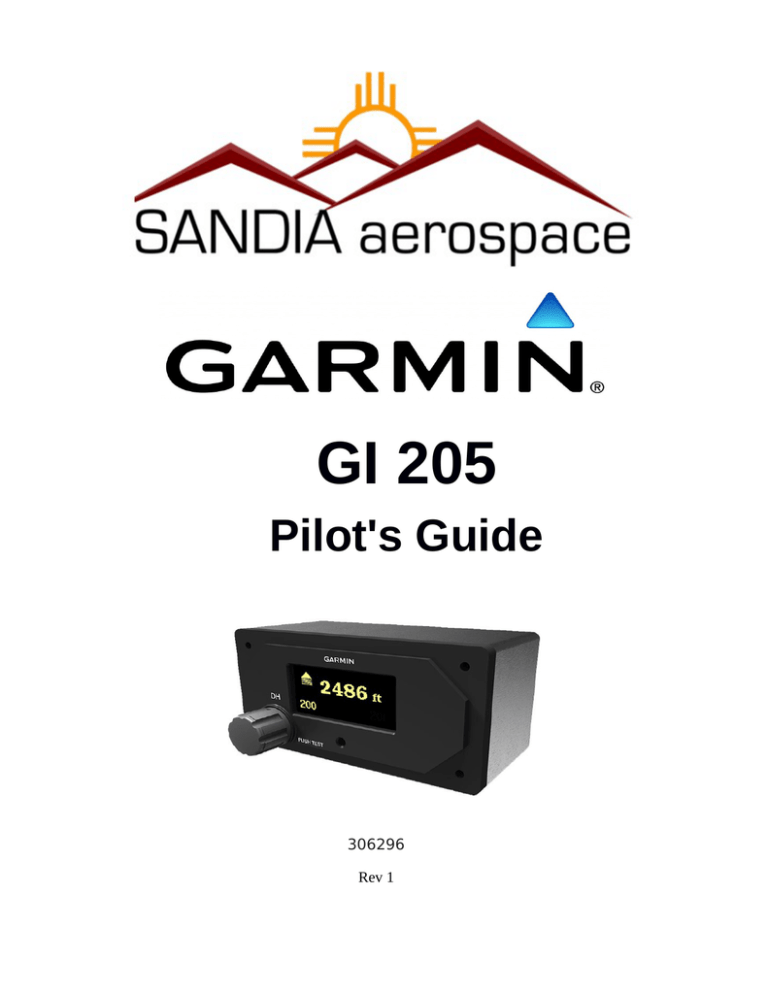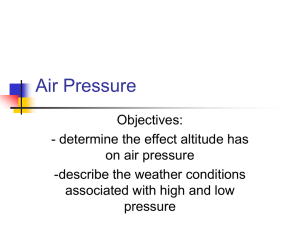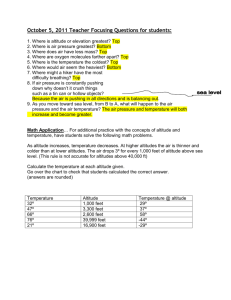
GI 205
Pilot's Guide
306296
Rev 1
This document and the information contained herein is the propriety data of SANDIA aerospace
Corporation. No part of this document may be transmitted, reproduced, or copied in any form or by any
means without the prior written consent of SANDIA aerospace.
Due to SANDIA aerospace’s continued product and quality improvement programs, information
contained in this document is subject to change without prior notice.
Copyright 2014 SANDIA aerospace Corporation, all right rights reserved.
Printed in USA.
Record Of Revisions
Revision
1
Date
Nov 21, 2014
Description
DRN 458
Approval
CLH
Table of Contents
1. Section 1 – GI 205 Overview............................................................................................................................1
1.1 Introduction..................................................................................................................................................1
1.2 GI 205 Product Description..........................................................................................................................1
1.2.1 Functions...............................................................................................................................................2
1.2.2 System Interfaces...................................................................................................................................2
2. Section 2 - Normal Operation............................................................................................................................3
2.1 Initial Power On............................................................................................................................................3
2.2 Pilot Display and Controls............................................................................................................................3
2.2.1 Push Test Button and Encoder...............................................................................................................3
2.3 Radar Altitude...............................................................................................................................................4
2.4 Decision Height............................................................................................................................................4
2.5 Decision Height Alerts..................................................................................................................................5
2.6 Trend Indicator..............................................................................................................................................5
2.7 “ALT1”.........................................................................................................................................................6
2.8 “ALT2”.........................................................................................................................................................6
2.9 Pilot Configurable Options...........................................................................................................................6
2.9.1 MIN BRIGHTNESS..............................................................................................................................6
2.9.2 VOLUME..............................................................................................................................................6
2.9.3 ALTITUDE UNIT..................................................................................................................................7
2.9.4 ALTITUDE TREND..............................................................................................................................7
3. Section 3 – Failure Conditions...........................................................................................................................8
3.1 Flash Check..................................................................................................................................................8
3.2 RAM Check..................................................................................................................................................8
List of Illustrations
Illustration 1: GI 205 Overview..............................................................................................................................1
Illustration 2: Power On Screen..............................................................................................................................3
Illustration 3: Display Elements..............................................................................................................................3
Illustration 4: Radar Altitude Highlighted...............................................................................................................4
Illustration 5: Decision Height Highlighted............................................................................................................5
Illustration 6: Minimum Brightness Adjustment.....................................................................................................6
Illustration 7: Volume Adjustment..........................................................................................................................6
Illustration 8: Altitude Unit Selection.....................................................................................................................7
Illustration 9: Altitude Trend Selection...................................................................................................................7
Section 1 – GI 205 Overview
1.1 Introduction
This manual describes the operation of the Garmin GI 205 Radar Altimeter Indicator
(manufactured by SANDIA Aerospace). The GI 205 is designed to operate exclusively
with the Garmin GRA 55 or GRA 5500 radar altimeters.
1.2 GI 205 Product Description
The GI 205 can be installed as a stand-alone display of radar altitude or in parallel with
an integrated avionics suite.
In a stand-alone installation, the pilot may input a Decision Height (DH) setting on the
GI 205 display, and the GI 205 deduces the DH crossover point and generates
appropriate visual and aural alerts. DH alerting in this scenario is independent of the
GRA 55/5500.
The GI 205 can also be installed in parallel with an integrated avionics suite. In this
scenario, the GI 205 provides a dedicated radar altitude display. The GI 205 can be
configured to disable the redundant local Decision Height alerts, and it can optionally
generate aural or visual alerts based on discrete outputs from the integrated avionics.
Illustration 1: GI 205 Overview
1
1.2.1 Functions
The GI 205 performs the following functions:
Receive and process ARINC Label 164
Visual and aural annunciations
Decision Height alert discrete output
Activate Self Test mode in GRA 55/5500
Display Radar Altitude (Meters/Feet)
Auto adjust the brightness of the display
Volume control
Enable/Disable Altitude Trend
Various parameters can be configured by the installer (not pilot accessible):
Altitude Filter Time Constant
Maximum Trend Scale
Trend Filter Time Constant
DH Display Name
DH Visual Alert
DH Aural Alert
Default Decision Height
ARINC 429 Speed
Select Rounding Options
1.2.2 System Interfaces
The GI 205 interfaces with Garmin GRA 55 and GRA 5500 radar altimeters via ARINC
429 interface.
Inhibit DH Input: If this discrete input is connected to ground, the decision height
functionality is masked from the display.
GRA Altitude Alert Discrete Input 1: If this discrete input is connected to the GRA 55 or
GRA 5500, the GI 205 provides a visual and aural annunciation when the input is active.
GRA Altitude Alert Discrete Input 2: If this discrete input is connected to the GRA 55 or
GRA 5500, the GI 205 provides a visual and aural annunciation when the input is active.
Aircraft power is the only electrical power interface.
2
Section 2 - Normal Operation
2.1 Initial Power On
Upon initial power-on, the unit will display the company logo, software version and
software checksum for about 10 seconds and then proceed to the normal display.
Illustration 2: Power On Screen
2.2 Pilot Display and Controls
The following shows the possible on-screen functions and pilot control during normal
operation.
Illustration 3: Display Elements
2.2.1 Push Test Button and Encoder
Pushing the “PUSH TEST” button activates the optional manually initiated self test
mode in the GRA 55 and GRA 5500 (if this functionality is connected between the GI
205 and the GRA). If the internal GRA self test passes, the GRA transmits a test altitude
of 40 ft, which is displayed by the GI 205. If the self test fails, the text “FAIL” will be
prominently displayed on the GI 205 display. This text cannot be removed from the GI
205 display unless power is cycled to the GRA.
If the manually initiated self test mode is currently inhibited by the GRA, the GI 205
will show “TEST INHIBITED” in place of “RADAR ALTITUDE” on the display, and
the self test will not initiate. Refer to the GRA 55 or GRA 5500 Installation Manual for
more information about the Self-Test and Self-Test Inhibit Functionality of the GRA.
A rotary encoder (turnable knob) is built in with the same “PUSH TEST” button.
Rotating the encoder during normal operation sets the Decision Height in the range of 0
to 2500 feet or 0 to 760 meters.
3
2.3 Radar Altitude
Current radar altitude is displayed below the “RADAR ALTITUDE” title text. The GI
205 can be configured to display the radar altitude in either feet or in meters.
If the GI 205 receives an indication that the unit providing the Radar Altitude has failed,
it will display “FAIL” in place of the Radar Altitude value.
If the GI 205 receives an indication that the unit providing the Radar Altitude is in self
test mode, it will display “TEST” in place of Radar Altitude.
2.4 Decision Height
Decision height is displayed below the “DH” or “MIN” text (based upon the “DH
DISPLAY NAME” configuration selection during installation). It is displayed either in
feet or in meters, based upon the “ALTITUDE UNIT” configuration selection during
installation.
Decision height is set by turning the encoder and changes by the factor shown in the
table below:
Decision Height Increment/
(in Feet)
Decrement
Factor
Decision Height
(in Meters)
Increment/
Decrement
Factor
0 to 200 Feet
10 Feet
0 to 60 Meters
3 Meters
200 to 500 Feet
50 Feet
60 to 150 Meters
15 Meters
500 to 2500 Feet
100 Feet
150 to 760 Meters
30 Meters
Table 1: Decision Height Increment/Decrement Factor
If the decision height alert is activated, and if the “DH VISUAL ALERT” field is
configured to “ALT FIELD” during installation, the Radar Altitude value will blink for
two seconds and then stay highlighted as long as the currently displayed radar altitude is
below (or up to 50 ft above) the selected decision height.
Illustration 4: Radar Altitude Highlighted
If the decision height alert is activated, and if the “DH VISUAL ALERT” field is
configured to “DH FIELD” during installation, the decision height text and the decision
4
height value will blink for two seconds and then stay highlighted as long as the currently
displayed radar altitude is below (or up to 50 ft above) the selected decision height.
Illustration 5: Decision Height Highlighted
2.5 Decision Height Alerts
The decision height alerts are activated if the currently displayed radar altitude crosses
below the set decision height. The alert is annunciated both visually and aurally. The
options for the visual alert are described in the above section. The GI 205 also plays an
aural alert heard as a “minimums, minimums” annunciation in a male or female voice or
a 1 kHz tone for two seconds, depending upon the “DH AURAL ALERT” configuration
selection during installation.
As stated in the above section, once the visual alert is active it remains active until the
displayed radar altitude reaches 50 feet above the set decision height, with one
exception. If the decision height is set to 0 feet (or meters), and if the displayed radar
altitude also becomes 0 feet (or meters), the alert becomes inactive after 1 second.
2.6 Trend Indicator
An altitude trend indicator is optionally displayed on the right side of the radar altitude
display. The trend indicator attempts to calculate the radar altitude trend (climb or
descent and relative magnitude thereof) based upon incoming altitudes from the GRA.
It consists of an up/down arrow and a maximum of five associated bars. Positive vertical
trend (climb) is indicated by an up arrow and associated bars below it. Negative vertical
trend (descent) is indicated by a down arrow and associated bars above it. The trend
indicator maps the arrows and bars to six trend points based upon the “MAX TREND
SCALE” value configured during installation (full deflection of the trend indicator). The
trend indicator displays only the up or down arrow when vertical trend reaches 8% of
the “MAX TREND SCALE” selection. It then adds a successive bar below/above the
arrow when vertical trend reaches 20%, 40%, 60%, 80% and 100% of the configured
“MAX TREND SCALE” value.
The altitude trend indicator can be hidden by disabling the “TREND INDICATOR”
configuration option during installation. The trend indicator display is also temporarily
disabled when the “PUSH TEST” button is depressed and the GRA enters the manually
initiated self test mode.
5
2.7 “ALT1”
If connected, when the GRA Altitude Alert Input 1 becomes active, the GI 205 plays the
configured aural alert for two seconds and blinks the “ALT1” text at the bottom row of
the display for two seconds. The text then stays visible and highlighted as long as the
input is active.
2.8 “ALT2”
If connected, when the GRA Altitude Alert Input 2 becomes active, the GI 205 plays the
configured aural alert for two seconds and blinks the “ALT2” text at the bottom row of
the display for two seconds. The text then stays visible and highlighted as long as the
input is active.
2.9 Pilot Configurable Options
Pressing and holding the “PUSH TEST” Button for 5 seconds enters the pilot
configuration mode. After entering the pilot configuration mode, pushing the “PUSH
TEST” button will cycle through the following user configuration pages: “MIN
BRIGHTNESS”, “VOLUME”, “ALTITUDE UNIT” and “ALTITUDE TREND”.
Once in the pilot configuration mode, the GI 205 will return to normal operation mode if
no input is received through the button or the rotary encoder for 8 seconds.
2.9.1
MIN BRIGHTNESS
Illustration 6: Minimum Brightness Adjustment
The minimum brightness level of the display can be selected in this configuration page.
Turning the rotary encoder changes the minimum brightness limit of the display. After
the GI 205 returns to the normal mode of operation, the dynamic control of the display
brightness is automatically controlled by the GI 205 photocell. The display becomes
brighter as the surrounding light gets brighter, and the display becomes dimmer as the
surrounding light gets dimmer (limited by the minimum brightness setting).
2.9.2
VOLUME
Illustration 7: Volume Adjustment
6
The aural alert volume can be set in this configuration page. Turning the rotary encoder
changes the volume. For monitoring purposes, the GI 205 plays the aural alert while on
this page to help adjust to the desired alert volume.
Setting the volume to the minimum setting will completely mute the aural alert.
2.9.3
ALTITUDE UNIT
Illustration 8: Altitude Unit Selection
The unit of the altitude display can be selected to “FEET” or “METERS” by turning the
rotary encoder in this configuration page. This configuration affects both the radar
altitude field and the decision height field.
2.9.4
ALTITUDE TREND
Illustration 9: Altitude Trend Selection
The altitude trend indicator can be selected to “ENABLE” or “DISABLE” by turning
the rotary encoder in this user configuration page. If “ALTITUDE TREND” is disabled,
the trend indicator will not be displayed during normal operation. If “ALTITUDE
TREND” is enabled, the trend indicator will be displayed per the description in Section
2.6.
7
Section 3 – Failure Conditions
3.1 Flash Check
The unit continuously checks for any errors in the internal Flash memory. If it
encounters an error, the unit will display “EOC CRC FAILED” and will become
inoperable. If this occurs, the GI 205 must be returned to the factory for service.
3.2 RAM Check
The unit checks for any errors in the internal RAM (random access memory) during unit
startup. If it encounters an error, the unit will display “RAM TEST FAILED” and will
become inoperable. If this occurs, the GI 205 must be returned to the factory for service.
8



